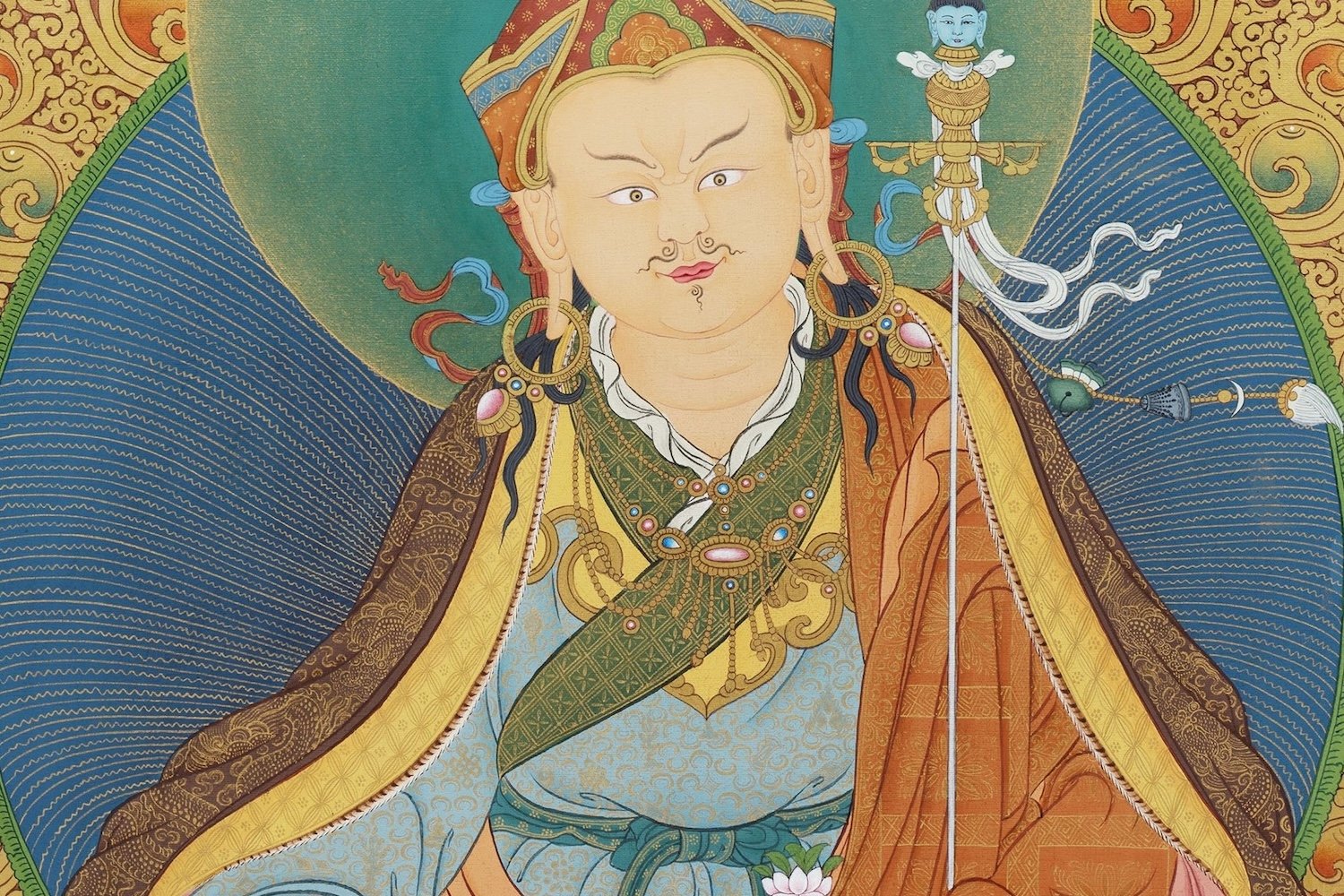A few weeks ago my partner and I went to a pro-Democracy rally a couple of miles down the road. I’d decided that I wanted to spend my time there meditating, so I took along a yoga mat and my meditation bench, and sat down to meditate. In front of me sat a piece of pink card on which I’d written in black sharpie, “Buddhists For Democracy.”
I’d planned to do lovingkindness meditation, and I did for the first few minutes. But very soon I realized I wanted to chant a mantra. I wanted to chant the mantra of Padmasambhava.
The mantra goes: Oṃ Āḥ Hūṃ Vajra Guru Padma Siddhi Hūṃ.
Sometimes I chanted the mantra under my breath. Sometimes I repeated it mentally.
I kept this going for an hour, while people cheered, passing cars honked their horns, and one guy yelled over and over, “You’re all criminals!”
Chanting the mantra felt like a very significant thing to do, but to explain that I’ll have to say a little about Padmasambhava.
The Precious Teacher
Padmasambhava has another name: Guru Rinpoche, the Precious Teacher. He lived in the 8th and 9th centuries, but there’s so much mythology surrounding him that it’s very difficult to know anything for sure about his life.
Legend says that he converted Tibet to Buddhism. He was founder of one of the major schools of Tibetan Buddhism, the Nyingmapa school.
The legends say he came from a place called Oddiyana. That might be the present-day Swat valley in Pakistan. At that time, Oddiyana was a major center of Vajrayāna Buddhism.
Maybe Padmasambha was born in Oddiyana, but there are conflicting accounts. Some stories say that he was the son of a local queen, but also he is said to have been born in the calyx of a lotus flower that appeared on Lake Danakosha, and appeared fully formed fully formed as an 8 year old boy, who King Indrabuti then then adopted. In fact, Padmasambha’s name means “born from a lotus.”
So you see what I mean about him being shrouded in myth. We really just have to approach him as a legendary or mythic figure. In the stories that are connected with him, we have to look for a more mythic sense of meaning.
What’s more certain is that he was a teacher of Dzogchen, which is the Tibetan for “Great Perfection.” Indian Buddhists called this Ati Yoga, or the “Highest Practice.” The aim is to see through appearances in order that we can rest in the innate luminosity and purity of the mind.
The part of Padmasambhava’s life I want to talk about is his conversion of Tibet to Buddhism.
Failure to Launch
King Trisong Detsen, 38th king of Tibet, wanted to convert his country. His first attempt at that was inviting a famous Indian monk called Shantarakshita.
Shantarakshita was a Mahayana monk who founded Samye monastery, where Tibetans could learn about traditional Buddhist teachings, like the Four Noble Truths and the Eightfold Path, and about newer Mahayana teachings. But at night the demons of Tibet destroyed all the work from the previous day.
Taking this as a kind of mythic truth, the way Shantarakshita was trying to introduce Buddhist practice to Tibet just didn’t work. It didn’t fit the local conditions. We can see the demons that dismantled the monastery at night as wild, destructive forces in the Tibetan psyche at that time.
Tibet at that time was a very wild, warlike country. It was full of power struggles. It was steeped in superstition, a place where people worshipped local deities and demons, and employed sorcerers to dispose of their enemies. Machiavellianism and magic were the demons of Tibet.
The rational, philosophical approach that Shantarakshita was trying to introduce just didn’t work for the Tibetans.
Converting the Demons of Tibet
So Shantarakshita in turn invited Padmasambhava. He was a great scholar, but he was also a deep meditator and a magician (siddhi). So when Padmasambhava arrived in Tibet, his main task was not to teach the Four Noble Truths and the Eightfold Path. It wasn’t to teach meditation. It was to get to grips with Tibet’s demons. He took them on in a kind of spiritual combat. In other words, in some way he tackled the wild forces in the Tibetan psyche.
He was fearless. The legends are that he battled demons until they revealed their secret names to him. And once he’d done that he was able to convince them to become protectors of the teachings, rather than opponents of them.
This, I think, means that he really got to know and understand what made the Tibetan people tick. And with that understanding he was able to show them that the Dharma (the path to awakening) was a superior way of living — in terms that made sense to them.
Padmasambhava was a Tantric teacher, and the Tantra doesn’t say “This thing you’re doing is bad; do the opposite.” It says something more like “This thing you’re doing may be bad, but the underlying energy behind it is neither good not bad, so take that energy and redirect it in a more helpful direction.”
Buddha 3.0
The Buddha himself did things like this. For example, he said, “The supreme conqueror is not one who conquers a million others in battle, but the one who conquers a single person: themselves.” He’s asking people prone to competition to channel their competitive energies in a more challenging and rewarding direction.
So I imagine Padmasambhava did something like this with the demons of Tibet (that is, Tibetan culture). Understanding what motivated Tibetans, he showed them a different way of being. He showed them a different kind of warriorship. A different kind of magic.
This isn’t an easy thing to do, because when we’ve committed to a certain way of being, it becomes our whole world-view. Bar some earth-shaking change in our lives, we just can’t imagine seeing things in a different way. It takes a true spiritual genius to tune in to people’s deep motivations and to open their minds to seeing a different goal, a different way of being.
The Buddha was a genius like that, and so was Padmasambhava, which is why Tibetans call him “The Second Buddha.”
Gautama was Buddha 1.0, and Padmasambhava was Buddha 2.0.
We’re deeply in need of a Buddha 3.0.
We need someone that can do battle with the demons of our own culture. This battle is not a literal one. It’s a metaphorical battle that involves cultivating insight and understanding rather than wielding weapons. It’s not a battle where we aim to destroy some in order to save others. It’s a battle without enemies, where we compassionately desire to help all beings. The battle is not aimed at defeating beings, but at defeating harmful ideas. And those ideas can only be defeated if we understand them, and understand why people hold them.
The Demons of the Modern Era
Every culture has its demons (and again, that’s destructive psychic and cultural forces, rather than actual demonic entities).
Here are four contemporary demons that have a powerful distorting effect on the human psyche.
1. Materialism
Materialism has to be one of the biggest contemporary demons. Here materialism refers to the belief that happiness comes from consuming and by having more.
While it’s obvious that freedom from financial worry allows us to be happier, there are diminishing returns from accumulating wealth. Psychology studies show that happiness mainly comes from things like being kind, having gratitude, self-compassion, mindfulness, and having a sense of meaning and purpose in life. These are also things that various spiritual traditions, including Buddhism, teach.
If materialism were a true source of happiness, Elon Musk would be the happiest person on the planet. Instead, he seems to be to be extremely unhappy, probably because he lacks all the true bases of a happy life.
The accumulation of wealth that we see in the world at the moment seems morbid. It’s as unhealthy as filling every inch of your house with old newspapers and empty food containers. It’s worse than that, since at least hoarding trash doesn’t generally harm other people. As Nathalie Robin said, “If a monkey hoarded more bananas than it could eat, while most of the other monkeys starved, scientists would study that monkey to figure out what the heck was wrong with it. When humans do it, we put them on the cover of Forbes.”
Materialism is creating vast inequalities, and it’s also destroying the ecological systems that allow us to have civilizations.
2. The Sanctity of the Free Market
Society is distorted by the belief that the free market is sacrosanct. Suggest limiting the power of a corporation to cause harm, and a whole bunch of people will call you a “communist” — although what you’re suggesting is that the duly elected representatives of the people take action to protect the majority of the people (us) from harms caused by a minority (the corporations in question).
It doesn’t really matter what you suggest — making it illegal to put poison in foodstuffs, for example — there are going to be people who say that it’s all up to the individual consumer, as if life should ideally consist of ordinary people going mano a mano against massive corporations that have bottomless pits of money for lawyers.
In reality, there is no such thing as a free market. Markets operate only because of laws and rules. A completely free market becomes a mafia state, where nothing is off the table, and everyone ends up strong-armed by the most ruthless. And there’s nothing free about that.
3. Short-termism
Businesses focus on their quarterly results, and sometimes they sabotage themselves in the long term, for example by cutting their research and development budgets, in order to produce short-term results.
A well-known New Yorker cartoon by Tom Toro shows a man and three children sitting by a camp fire, a ruined city in the background. The man says, “Yes, the planet got destroyed. But for a beautiful moment in time we created a lot of value for shareholders.”
Short-term thinking is the opposite of wisdom. The Buddha used to ask, “What is for my long-term happiness and well-being?” He advised us to use that perspective as a guide for life.
The Toro cartoon illustrated the short-termism inherent in our attitude to the environment. Corporations focus on short-term profits. Our atmosphere is accumulating carbon dioxide, and as it does so it gets hotter, weather patterns are disrupted, and sea levels rise. Corporations’ efforts to maximize their profit will have catastrophic effects, but this doesn’t factor into their thinking. Those costs will be borne by others. Their profits are private, while the cost of creating those profits is public.
It’s not just corporations, of course. Individuals play a part. But it’s mostly big business that is the problem.
4. Tribalism
The Buddha points out that every one of us is subject to sickness, old age, death, and the loss of everything that is precious to us. We’re all in it together. He then in effect asks us how, knowing this, we are going to live. Given these facts, the most appropriate way for us to live is compassionate recognition of our shared plight as human beings.
Those who don’t get that we’re all in this together are usually in the grip of fear. Studies show that many people, when they are reminded of impermanence, loss, and death, cling tightly to some form of identity. They identify with one group, which they see as existing in opposition to other groups. They see their own group as inherently superior. Others just don’t matter. They may even be seen as the enemy. Tribalism says that hating, persecuting, or destroying this enemy is what’s needed to bring happiness. Currently, tribalism’s popular enemies are immigrants and trans people.
All of us are tribal to some extent. It’s part of human nature to align with other groups of people. But tribalism forces us into a narrow form of empathy, where we have a limited capacity for compassion unless it’s for people similar to us. Buddhist practice — and Christian practice too, in theory — encourages us to see past tribalism so that we can relate to all people as fellow humans, and all living beings as fellow feeling beings.
Conservatives are more prone to fear (possibly for genetic reasons) and so are more likely to fall into tribalism, but liberals do this as well. Liberals often talk about compassion, but end up despising those they think are uncompassionate. They rarely see the irony in this. They may assume that if they show enough disdain, conservatives will want to become better people.
Buddha 3.0
These four things — materialism, the false idol of the free market, short-termism, and tribalism — are not the only demons in western culture. They’re just the ones I notice most often. They are all tangled up with each other, in ways I don’t need to spell out. I could also have mentioned individualism, the denial of evidence, and the naive techno-optimism of what’s been called the TESCREAL movement.
Padmasambhava did not destroy the demons of Tibet. Instead he recognized their essential energy and offered it a sacred purpose. We need to do the same with contemporary demons. We need not simply to condemn them, but to understand them deeply. Padmasambhava learning the secret names of the demons of Tibet means he understood their essence.
To understand the essence of cultural forces does not just mean knowing a bunch of facts. It means understanding the minds that are caught up in those forces. And since our own minds are entangled in the demonic cultural patterns I described above, we need to understand our own minds. We might look at fascists in horror, but there’s a bit of fascism in all of us. To understand them, we have to look at ourselves.
The Deep Listening of Compassion
When we see people with views we profoundly disagree with, our instincts say: let them know they’re wrong, criticize what they say, tell them what (in our eyes) is true! Yet arguing with people is remarkably ineffective at changing their minds. Even giving them new information doesn’t work.
What has been shown to work, over and over again, is starting from a place of empathy, refraining from criticism, and asking questions that encourage them to unpack their thinking. Often when people explain themselves fully they start to change their minds. In today’s polarized world they’re rarely given a chance to talk in depth about their beliefs. They often simply confirm with other members of their tribe what they, as members of the same tribe, are supposed to believe. And when challenged by outsiders they become defensive or aggressive. These are not good conditions in which to reflect.
Because they haven’t explained their beliefs to others, they’ve never explained them to themselves, either. They don’t know what they really believe until they make it appear for an interested, empathetic listener. Only then can they become aware of weaknesses and limitations in their thinking. If you give them a chance to do this, by asking questions in a nonjudgemental way — having shown that you’re a non-threatening listener — you can then ask them more probing, critical questions, and present them with information that’s new to them. Freed from the need to be defensive, they can reflect. This is what changes minds.
Because we’re tribal, we rarely talk to people this way. Our main interest is showing people who are not in our tribe that they are wrong and bad.
To learn the secret names of the demons, we have to leave no place in our hearts for hatred, resentment, and contempt. This means learning to recognize those unskillful states, which are often hidden from us. They hide in plain sight in our minds, but we don’t recognize them because we take them to be “righteous anger.” We think our outrage shows our rightness. It doesn’t. It shows that we have a sense of superiority, and are thus under the sway of the demons. Understanding the demons means recognizing whatever stands in the way of love and compassion, and letting it dissolve away.
This does not mean “being nice.” Being nice usually means not wanting to challenge people. Padmasambhava challenged people big-time. But he did it without hatred, out of compassion. The combination of incisive challenge and and care for the people (or their ideas and actions) being challenged is illustrated by Padmasambhava’s famous “wrathful smile.”
We Can’t Wait For the Buddha
Unfortunately, it’s unlikely that a new Buddha will appear in the calyx of a lotus flower in the midst of a mountain lake. He or she is not going to appear from a Pure Land or be born from a queen.
We can’t wait for a savior.
It’s up to us. We have to become the saviors. We are all invited to become emanations of Padmasambhava. Buddha 3.0 is the sum total of out collective awakening. It’s a movement of minds committed to understanding the modern psyche with the same skillful means Padmasambhava had mastered.
We need to learn the demon’s secret names; to dig deep; to look closely at our reactivity and overcome it with compassion. We need to understand others with compassion — not just feeling warmth toward them, but compassionately and empathetically understanding how they think. What makes them tick? Why do they believe the things they believe and do the things they do?
The answer to such questions can never be “Because they’re stupid” or “Because they’re evil.” The answer has to be framed in terms they themselves would recognize and assent to. It has to be framed in the same terms you would use if you thoughtfully described why you believe the things you believe, and do the things you do. Because you’re the same as them. You have the same fundamental desires for freedom, safety, and to matter. You just go about trying to fulfill those desires in a different way. We need to understand those desires if we’re to help the world find better ways to meet them.
So this is why chanting the Padmasambhava mantra seemed significant. It felt like I was sending something powerful into the world. It wasn’t coming from me, but simply flowing through me. I was chanting an invocation to call forth Buddha 3.0 — inviting awakening to emerge and convert our modern demons. Consider yourself invited.
A Spiritual To-Do List
Invitations are good, but we have a lot of work to do on ourselves.
- We need to reject materialism, living with greater simplicity even if it’s sometimes inconvenient. Think: low carbon, low plastic, plant-based. We need to find meaning and satisfaction in our lives through friendship, spiritual community, and compassionate action.
- We need to reject the false idea that “freedom” consists of allowing the powerful to do whatever they want. We need to see freedom as what allows all people to live happy, fulfilled, creative lives to the best of their ability. We desperately need a society with less inequality and greater fairness: a society that works for the benefit of all. This is not radical; this is common-sense.
- We need to reject short-termism, considering what’s best for our own and others long-term happiness and well-being. It’s too late for us to leave a better world to our children and grandchildren than the one we were born into, but we have to think about how to mitigate the damage we’ve caused, and to create the best possible circumstances for our children and for future generations.
- We need to free ourselves from tribal thinking — especially political, national, and racial thinking. We need to question our own beliefs and live with honest intellectual humility, recognizing the limits of our knowledge. We need to start from the basis of seeing that we’re all in it together.
So it’s up to us to be Buddha 3.0. Needless to say, this isn’t an easy thing. It’s not something we can do all at once. It’s a life-long task. So why not begin now?
What will your next step be?

Wildmind is a Community-Supported Meditation Initiative. Click here to find out about the many benefits of being a sponsor.
Publisher: Source link






